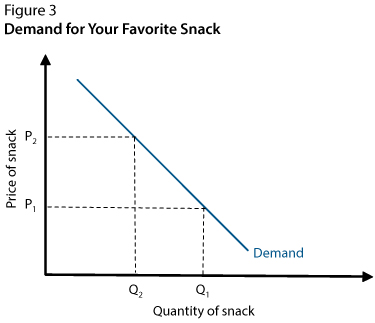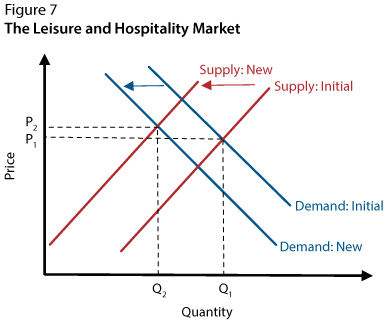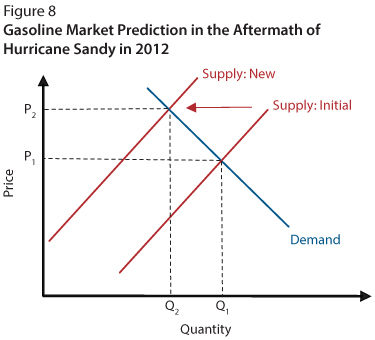The Science of Supply and Demand

"A body in motion tends to stay in motion unless acted on by an out-side force."
—Isaac Newton
Science Is Everywhere
We live in a world governed by the laws of science. From gravity, to electromagnetism, to sound waves, our lives are filled with scientific phenomena that structure and affect every facet of our daily routine. As a species, we have attempted at every turn to channel the laws of science to our own benefit, constantly working to build better products and to develop improved means of manufacturing. However, sometimes science unveils itself in unanticipated ways—ways that often force its will on the distribution of goods in markets.
Figure 1
Personal Consumption Expenditures
SOURCE: FRED®, Federal Reserve Bank of St Louis; https://fred.stlouisfed.org/graph/?g=r60z, accessed January 2021.
Few events demonstrate this fact better than the COVID-19 pandemic of 2020. As this new viral strain spread around the globe, many businesses in the United States closed or reduced workers' hours, sometimes by the choice of businesses—to prevent employees from catching the virus—and sometimes due to government stay-at-home orders.1 In the early months of the pandemic, virtually no industry or market remained unaffected as the economy declined: Consumer spending on goods and services dropped by 6.7 percent in March and 12.7 percent in April (Figure 1) and the unemployment rate rose from a 50-year low of 3.5 percent in February to a post-Great Depression record of 14.7 percent in April (Figure 2).
Figure 2
Unemployment Rate
SOURCE: FRED®, Federal Reserve Bank of St. Louis; https://fred.stlouisfed.org/graph/?g=r5AM, accessed January 2021.
Supply and Demand
COVID-19 affected markets the same way they are affected by any outside force—through supply and demand. In competitive markets, supply and demand govern the ways that buyers and sellers determine how much of a good or service to trade in reaction to price changes.
The law of demand describes the behavior of buyers in markets: As the price (P) of a good or service rises, the quantity demanded (QD) of that good or service falls. Likewise, as the price of a good or service falls, the quantity demanded of that good or service rises. Consider your favorite snack food. A downward sloping demand curve indicates that as the price of the snack increases, you would be able and/or willing to buy a smaller amount. This relationship is demonstrated by the downward sloping demand curve in Figure 3. When the price increases from P1 to P2, the quantity demanded decreases from Q1 to Q2.


Similarly, the law of supply describes the behavior of sellers in markets: As the price of a good or service rises, the quantity supplied of that good or service rises. Likewise, as the price of a good or service falls, the quantity supplied of that good or service falls. Therefore, as the price (as determined by the market) of your favorite snack rises, firms are willing to produce more units. This relationship is demonstrated by the graph of the upward sloping supply curve in Figure 4. When the price increases from P1 to P2, firms are willing to supply a greater quantity. That is, the quantity supplied increases from Q1 to Q2.

Market prices are constantly adjusting to bring into balance the amount desired by buyers and the amount sold by sellers. This balance is found at the equilibrium price, where supply and demand intersect (Figure 5). At this point we have our equilibrium price (Pe) and equilibrium quantity (Qe).
Scientific Events
Biology: COVID-19
The COVID-19 pandemic and the associated lockdowns hit the Leisure and Hospitality sector particularly hard (Figure 6). A recent study looked at hours worked by sector in the immediate aftermath of stay-at-home orders—March 2020.2 As shown in Figure 6, the effects on hours worked are separated into supply factors (red bars) and demand factors (blue bars) and measured as the percent change in historical growth rates of hours worked in each sector. Supply factors are related to businesses partially or fully shutting down. Demand factors are related to reduced consumer spending, such as from customers not shopping, to avoid catching the virus, or simply cutting back on spending due to income loss.3 For most sectors, hours worked dropped compared with historical trends due to both supply and demand factors.

When a factor other than price affects supply or demand, it is modeled by shifting the supply or demand curve, respectively, rather than moving along the curve. For increases in supply or demand, the curves are shifted to the right to higher quantities. For decreases, the curves are shifted to the left to lower quantities.

Although supply factors contributed to most of the almost 10 percent drop in the Leisure and Hospitality sector in March 2020 compared with historical growth, demand factors also contributed (see Figure 6). The change in this sector is demonstrated in Figure 7: Demand decreases (shifts to the left) and supply decreases more (also shifts to the left), resulting in a lower quantity of goods sold at the new equilibrium (Q2).4
Meteorology: Hurricane Sandy
In the fall of 2012, Hurricane Sandy hit New York City and surrounding regions, with millions of citizens and thousands of businesses losing power. In New Jersey, only 40 percent of gas stations tracked by AAA had power and were operational in the immediate aftermath of the hurricane.5 As a result, consumers faced a severe shock to the supply of gasoline.

Applying the laws of supply and demand, one can predict how this event would change the quantity and price of gasoline at the pump: Assuming unchanged demand,6 the supply curve would shift to the left (Figure 8). The equilibrium quantity would decrease from Q1 to Q2, with the price increasing from P1 to P2.
Did this occur? Not exactly. New Jersey Governor Chris Christie promised to punish gas stations that significantly increased prices above their pre-hurricane levels (P1).7 As a result, prices remained low because they were not allowed to reach equilibrium, so oil firms had no incentive to bring extra gasoline to the market at the lower price, long lines of vehicles formed, and many stations sold out due to limited supply.
Chemistry: The Ethanol Fuel Boom
In the late 2000s, ethanol experienced a boom as an alternative fuel. Compared with gasoline, ethanol was believed to be cleaner burning (produce less carbon dioxide) and could be produced from renewable crops such as corn and sugar cane.8 With subsidies provided by the U.S. government to produce fuel ethanol, production facilities sprouted up across the Midwest and supply increased in this growing industry.9
With more and more ethanol being blended into gasoline for use in everyday car engines, many believed that yearly production would continue to grow for years to come. Then, consumers began noticing that their gas engines were being damaged by gasoline mixtures with large percentages of ethanol.10 As it turns out, the chemical nature of ethanol makes it very attractive to water. When water gets into an engine's fuel, it increases the corrosion of metal and degrades the engine. As a result, regulators decided that gasoline for normal car engines could only contain up to 10 percent ethanol by volume.11,12

Using supply and demand to analyze fuel ethanol markets is a little tricky due to the volume ethanol limit. In Figure 9, the desire of producers to increase the supply of ethanol is indicated by the rightward shift of the supply curve. Producers would expect ethanol buyers to continue increasing their demand as ethanol becomes more and more popular. However, all else being equal, once buyers are running their vehicles with gasoline with 10 percent ethanol, their desire to purchase more would dramatically decrease and the demand curve would become a nearly straight vertical line.13 That is, the quantity demanded wouldn't increase much beyond this limit even if the price of ethanol were to decrease because people won't use gasoline with more than 10 percent ethanol. Thus, no matter how much producers wish to increase supply, buyers would not buy much more ethanol and increased production of ethanol would drive down prices.

Figure 10
U.S. Fuel Ethanol Consumption and Percent of Motor Gasoline Consumption, 1981-2019 (June 24, 2020)
Figure 10 confirms this analysis of supply and demand. Fuel ethanol consumption increased dramatically during the 2000s and then flattened out when it reached about 10 percent of motor gasoline consumption.14
Conclusion
Markets provide a means by which individuals and businesses can trade goods and services. Though goods and services come in many shapes and sizes, they are all governed by the laws of supply and demand. Of course, unanticipated scientific events, such as pandemics and hurricanes, can alter the course of markets. Yet, the same laws that make markets function every day will exert their will—the laws of supply and demand.
Notes
2 Brinca, Pedro; Duarte, Joao B. and Faria-e-Castro, Miguel. "Is the COVID-19 Pandemic a Supply or a Demand Shock?" Federal Reserve Bank of St. Louis Economic Synopses, 2020, No. 31; https://research.stlouisfed.org/publications/economic-synopses/2020/05/20/is-the-covid-19-pandemic-a-supply-or-a-demand-shock.
3 Some sectors such as Wholesale Trade and Information were positively impacted by demand factors. In the case of the Information sector, the increase may have been caused by families increasing their demand for goods and services to work, communicate, and/or enjoy entertainment from home.
4 Figure 7 depicts price increasing, but price could decrease depending on the size of the supply and demand shifts and how responsive supply and demand are to price changes.
5 Smith, Aaron. "Gas Shortage Continues in Areas Hit By Sandy." CNN Business, November 2, 2012; https://money.cnn.com/2012/11/02/news/economy/gas-shortage-sandy/index.html.
6 There could actually have been an increase in demand from individuals using gas powered electric generators during the power outage.
7 Futrelle, David. "Post-Sandy Price Gouging: Economically Sound, Ethically Dubious." Time, November 2, 2012; https://business.time.com/2012/11/02/post-sandy-price-gouging-economically-sound-ethically-dubious/.
8 U.S. Energy Information Administration. "Biofuels Explained: Ethanol and the Environment." December 7, 2020, update; https://www.eia.gov/energyexplained/biofuels/ethanol-and-the-environment.php.
9 Byrge, Joshua A. and Kliesen, Kevin L. "Ethanol: Economic Gain or Drain?" Federal Reserve Bank of St. Louis Regional Economist, July 1, 2008; https://www.stlouisfed.org/publications/regional-economist/july-2008/ethanol-economic-gain-or-drain.
10 Johnson, M. Alex. "Mechanics See Ethanol Damaging Small Engines." NBC News, August 1, 2008; https://www.nbcnews.com/id/wbna25936782.
11 Tyner, Wallace E.; Brechbil, Sarah l. and Perkis, David. "Cellulosic Ethanol: Feedstocks, Conversion Technologies, Economics, and Policy Options." Congressional Research Service, October 22, 2010; http://nationalaglawcenter.org/wp-content/uploads/assets/crs/R41460.pdf.
12 Specialty vehicles with anti-corrosive engine parts were sold to accommodate fuel with higher concentrations of ethanol, including E85, a fuel mixture containing 85 percent ethanol. However, such vehicles and fuel types have yet to gain mass popularity.
13 The demand curve would likely not be fully vertical, as decreases in any fuel component's price, like ethanol's, would increase the quantity demanded of fuel. However, because ethanol makes up a small percentage of fuel, the demand curve is assumed to be nearly vertical.
14 U.S. Energy Information Administration (2020). See footnote 8.
© 2021, Federal Reserve Bank of St. Louis. The views expressed are those of the author(s) and do not necessarily reflect official positions of the Federal Reserve Bank of St. Louis or the Federal Reserve System.
Glossary
Biology: The study of living organisms.
Chemistry: The branch of science that deals with the identification of the substances of which matter is composed.
Competitive markets: Markets in which there are generally many buyers and many sellers so that each has a negligible impact on market prices.
Demand: The quantity of a good or service that buyers are willing and able to buy at all possible prices during a certain time period.
Equilibrium price: The price at which quantity supplied and quantity demanded are equal. The point at which the supply and demand curves intersect.
Meteorology: The branch of science concerned with the processes and phenomena of the atmosphere, especially as a means of forecasting the weather.
Subsidies: Payments made by the government to support businesses or markets. No goods or services are provided in return for the payments.
Supply: The quantity of a good or service that producers are willing and able to sell at all possible prices during a certain time period.


 follow @stlouisfed
follow @stlouisfed